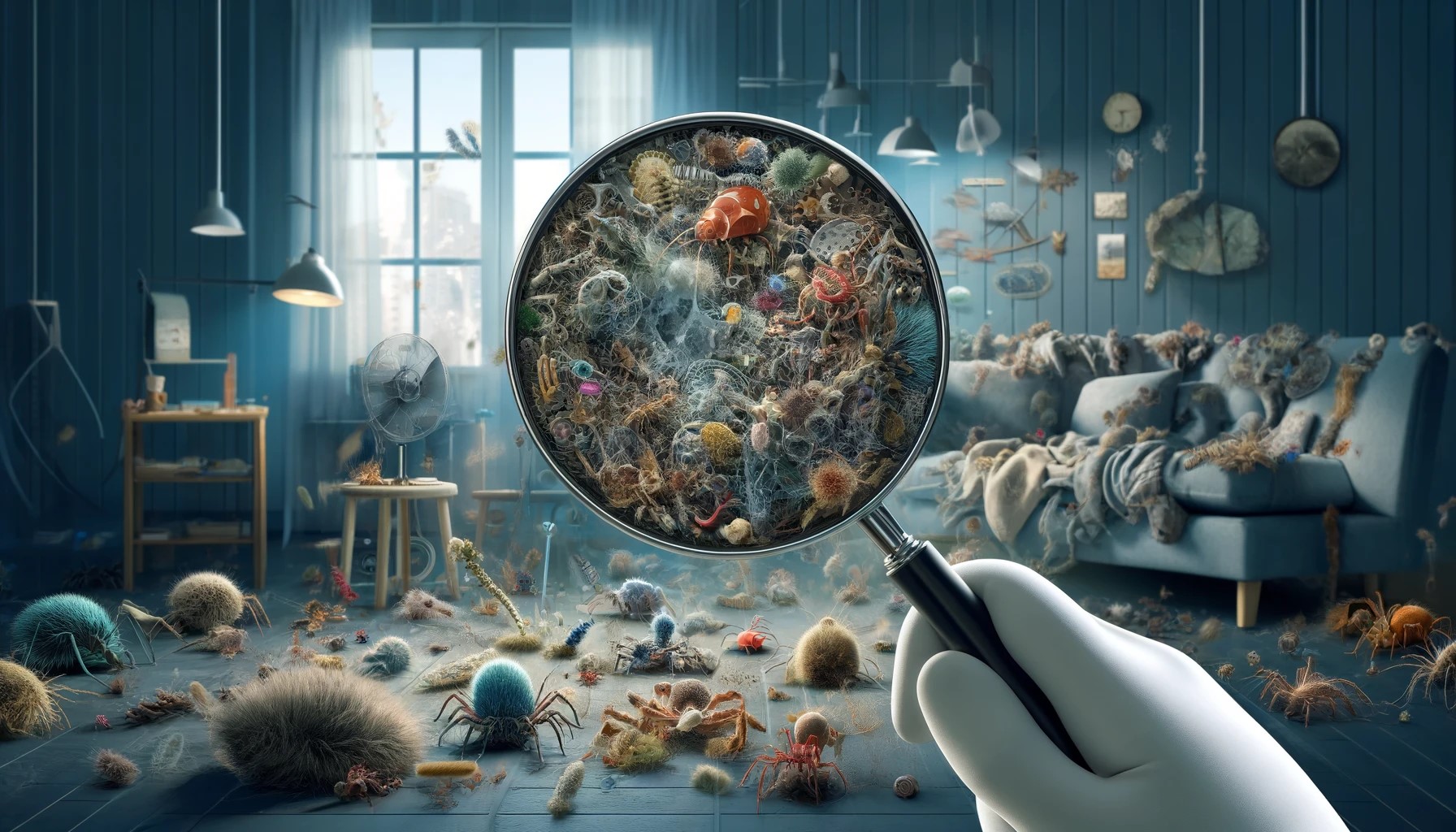What lives in our dust?
Table of Contents
Our home’s dust is a cocktail of many types of organisms, as well as skin and hair cells from our bodies and our pets. It includes tiny microparticles of the food we eat and particles from our clothing and the products we use. It is a combined micro-universe that contains evidence regarding our existence and lifestyle.
Amongst the various organisms that make this their home, one of the most common is Dermatophagoides, known as dust mites. Although too small to be seen with the naked eye, these microscopic creatures have a substantial impact on our lives, particularly in the realm of allergic reactions and respiratory health. In this blog, we will delve into the world of Dermatophagoides, exploring their characteristics, impact on human health, and methods to minimize their presence in our homes.
For More articles check the meetyourmicrobe website.
Taxonomy and classification:
Dust mites belong to the Arachnid family Pyroglyphidae, which is a specific family within the order Sarcoptiformes. This family includes several species of dust mites with the most common and well-known species being Dermatophagoides pteronyssinus and Dermatophagoides farina. Thus, making them distant relatives of spiders and ticks. Their minuscule size, ranging from 0.2 to 0.3 millimeters, renders them invisible to the naked eye. This microscopically small stature allows them to navigate even the tiniest of spaces, making our homes an ideal environment for their survival.
Social Creatures:
Dust mites are social organisms that tend to live in large groups. They congregate in areas where dead skin cells, their primary food source, are abundant. Common gathering places include bedding, upholstered furniture, carpets, and curtains. These areas provide warmth, humidity, and a readily available food supply. The communal nature of dust mites allows them to thrive and reproduce more effectively. In group settings, they produce higher quantities of fecal pellets and shed skin fragments which contain the allergenic proteins that trigger reactions in sensitive individuals. However, although they live in communal settings, they have limited social behavior or hierarchical structures as seen in other animal communities.
Diet and Digestion:
The diet of dust mites mainly consists of dead skin cells shed by humans and animals. As we go about our daily lives, our skin constantly sheds tiny particles, providing a bountiful feast for these arachnids. Dust mites possess digestive enzymes that help break down the proteins in skin flakes, facilitating their digestion. Contrary to popular belief, dust mites are not parasites. They do not bite humans or pets, nor do they burrow into our skin. Instead, they primarily feed on the dead skin cells that we naturally shed. While dust mite allergens can cause allergic reactions and respiratory issues in sensitive individuals, the mites themselves do not cause direct harm.
Reproduction and Lifespan:
Dust mites have a relatively short lifespan, typically living for about 2 to 4 months. However, during their brief existence, they reproduce prolifically. A female dust mite can lay up to 40 to 80 eggs in her lifetime. These eggs hatch into larvae, which go through several molting stages before reaching adulthood. The entire life cycle, from egg to adult, lasts 2 to 3 weeks under favorable conditions.
Sensitivity to Environmental Factors:
Dust mites thrive in warm and humid environments, with an optimal temperature range of 68 to 77 degrees Fahrenheit (20 to 25 degrees Celsius). They are highly sensitive to changes in humidity levels and struggle to survive in environments with low humidity. This sensitivity explains why they are commonly found in regions with humid climates.
Human Allergies and Health Implications:
For many individuals, Dermatophagoides can trigger allergic reactions and respiratory issues. The microscopic fecal pellets and shed skin fragments of these mites contain allergenic proteins that can become airborne and easily inhaled. Common symptoms of dust mite allergy include sneezing, itching, watery eyes, nasal congestion, coughing, and asthma exacerbation in sensitive individuals. Prolonged exposure to dust mites can contribute to the development of allergic rhinitis and asthma.
Managing Dust Mite Allergens:
While complete elimination of dust mites from our homes is nearly impossible, there are several strategies to minimize their presence and reduce allergen exposure:
Regular Cleaning: Vacuuming carpets and upholstered furniture, washing bedding in hot water (130 degrees Fahrenheit or above), and dusting surfaces with a damp cloth can help remove dust mites and allergens.
Allergen-Proof Covers: Encasing mattresses, pillows, and box springs in allergen-proof covers creates a barrier that prevents dust mites from colonizing these areas and minimizes exposure to their allergens.
Humidity Control: Since dust mites thrive in humid environments, maintaining a relative humidity level below 50% can help inhibit their growth. The use of dehumidifiers and proper ventilation in bathrooms and basements can aid in achieving this.
Minimizing Clutter: Reducing clutter in our living spaces, as well as minimizing the number of stuffed toys and other dust-collecting items, can limit the dust mite population.
Conclusion:
Dermatophagoides, the dust mites, may be invisible to the naked eye, but their impact on our health should not be underestimated. By understanding their habits, implementing proper cleaning practices, and managing our indoor environments, we can minimize the presence of dust mites and reduce the risk of allergic reactions. Prioritizing a clean and healthy living environment will go a long way in ensuring our well-being and respiratory health in the long run.
Remember, knowledge and awareness are the keys to combating these tiny creatures and creating an allergen-free haven in our homes.




